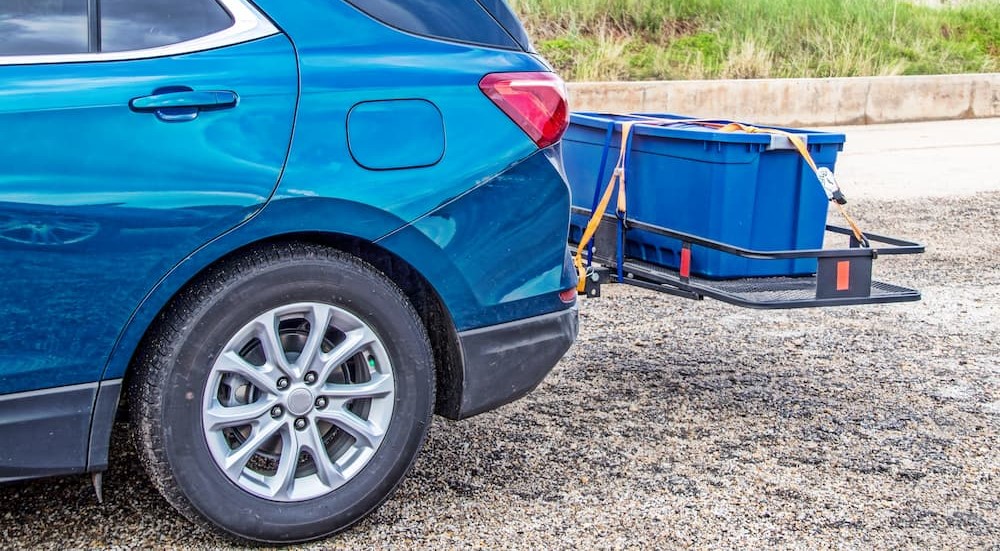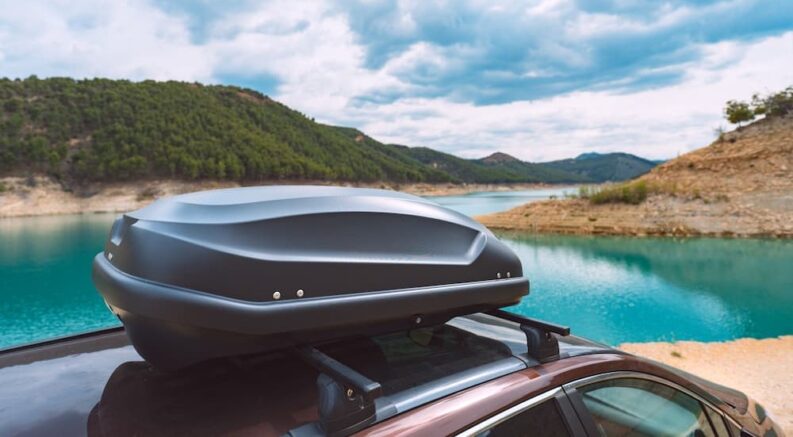Between passengers, groceries, camping supplies, and outdoor equipment, your car, truck, or SUV can feel a little cramped when you’re gearing up for your next family road trip. Today’s vehicles are built with more storage solutions than ever, with fold-flat seats, adjustable floors, and clever cubbies spread across the interior. Many EVs even sport an additional front trunk, or “frunk,” where a gas engine would normally be located, further expanding storage options and allowing drivers to bring along everything they might need for an extended journey.
That said, sometimes even the roomiest model just won’t cut it. That’s where external storage options come in. From roof-mounted racks and cargo boxes to hitch-based systems and even trailers, plenty of aftermarket products are designed to increase capacity without making for a cramped interior. How do they compare? Read on as we take a closer look at these storage solutions, weigh the pros and cons, and see just how easy it can be to increase your vehicle’s cargo capacity.
Roof-Mounted Racks and Cargo Boxes
Pros: Roof-mounted cargo boxes are the old standby for increasing external storage. Anyone who grew up watching the passing traffic on a family road trip probably remembers the Sears X-Cargo rooftop cargo box, which left its mark on the industry with its exceedingly 1990s beige color and speedy snail graphic. From the new generation of expansive, lightweight roof racks to classic, shell-like cargo boxes that have been the go-to for vacationing families throughout the decades, these roof-mounted storage options are a great way to increase a vehicle’s carrying capacity without overloading the interior.
Outfitting your vehicle with a roof-mounted rack or cargo box is usually rather easy. Many of today’s full-size SUVs and crossovers come standard with roof rails and rudimentary rack systems, which can be used to mount dedicated cargo boxes and other rooftop storage. When it comes to vehicles that aren’t quite so well-equipped out of the factory, drivers will need to invest in an aftermarket system that can accommodate the installation of cargo boxes and roof racks. These systems will typically run around $200 to $800, depending on the vehicle’s specific make and model. Thule has become the go-to name in the segment. While the Swedish company’s products are undeniably well-designed, reliable, and spacious, they’re also pricier, with Thule Motion XT Rooftop Cargo Carrier running over $2,400.
Roof-mounted cargo systems offer several advantages over hitch-mounted storage solutions and trailers. First, they provide superior weather protection, keeping your camping gear, clothes, and other supplies shielded from the elements and secure thanks to a built-in lock system. Unlike hitch-mounted cargo systems, roof-mounted options won’t block a vehicle’s trunk or rear hatch, improving convenience by allowing drivers to access every part of the vehicle at all times. Roof-based solutions are also a great choice when it comes to the type of cargo you rather not pack inside the vehicle itself. Take skis and snowboards, for example. On the way to the mountain, their sharp edges can create a safety hazard for passengers and upholstery. After a long day of skiing, these snow-caked skis and snowboards can also make a real mess, so relegating them to the roof is a popular solution.
Cons: Of course, there are some disadvantages to the roof-based approach. These high-riding storage solutions impact a vehicle’s aerodynamics, reducing fuel economy and making for a noisier ride. This issue is less prevalent with roof-mounted cargo boxes, which tend to be designed with aerodynamics in mind. The same can’t be said for roof-mounted cargo racks, which can create serious wind resistance depending on how they’re designed and loaded with gear.
The issue can be somewhat addressed by adding a rooftop cargo bag, a relatively new addition to the market that combines the capacity of a roof rack with some of the aerodynamic advantages offered by a traditional cargo box. These waterproof cargo bags retail for as little as $85 and provide up to 20 cubic feet of additional space. Cargo bags can be used in tandem with rooftop racks or affixed to almost any vehicle, including many cars, with a slip-proof mat.
Roof-mounted storage systems also tend to be more vehicle-specific than hitch-mounted versions, which can normally be outfitted to any vehicle with a standard two-inch hitch receiver. Roof-mounted systems vary in size and design based on the specific dimensions of a particular make and model, meaning drivers often have to invest in a new setup when upgrading to a new vehicle. Some drivers might have trouble fitting a vehicle with a roof-based cargo system inside their garage, or experience difficulties in public parking garages, drive-throughs, and other low overhangs.
If you’re looking to transport heavier items, a roof-based cargo box or roof rack might not meet your needs, with an average weight rating of between 150 and 200 pounds. On the other hand, hitch-mounted systems can typically accommodate up to 500 pounds of additional cargo, making them a more practical choice for heavier items. Finally, there’s the issue of accessibility. Lifting items into a roof-mounted cargo box or rack can be difficult, to say the least, and becomes a real chore when constantly hefting items that will see daily use.

Hitch-Mounted Cargo Boxes and Racks
Pros: Roof-mounted cargo racks and boxes might make sense for some drivers but can often be a little difficult to pair with a smaller vehicle due to the limited space and curve of the roof. That’s where hitch-mounted cargo boxes and racks come in. As the name implies, these cargo boxes and racks are attached directly to a vehicle’s trailer hitch, enabling drivers to add extra storage capacity without installing an entire roof-based mounting system.
These hitch-mounted cargo boxes and racks offer several advantages over the roof-based alternatives. First off, they tend to offer improved aerodynamics. They’re located behind the vehicle, where they create less wind resistance. According to a study by the U.S. Department of Energy’s Office of Energy Efficiency & Renewable Energy, a roof-mounted cargo box can lead to a 25 percent decrease in fuel economy compared to a hitch-mounted system. This is an especially important consideration for today’s electric vehicles, designed to be as aerodynamic as possible to extend their range. Certain EVs, especially smaller sedan-based models, advise against placing any sort of additional storage on the roof, making hitch-mounted products the only real alternative.
Hitch-mounted cargo boxes or racks can usually be paired with an existing bike rack. Their location also goes a long way towards improving comfort and noise. A roof-mounted rack or cargo box might create a noticeable hum or vibration when cruising at highway speeds, but hitch-mounted options avoid all of that or at least make it much less noticeable.
If you’re looking to maximize storage, a hitch-mounted cargo rack or box can greatly complement an existing roof-based system. Drivers can drastically expand their vehicle’s carrying capacity between the roof and hitch-mounted storage. Some hitch-mounted options even double as a mobile kitchen, allowing drivers to bring everything including the kitchen sink along for the ride. Take the Hitch Grill Station from StowAway2, for example. This hitch-mounted rack comes with a Cuisinart grill, cutting board, and additional cargo space, giving drivers the chance to go from cruising the highway to grilling up their favorite brats at a moment’s notice.
Hitch-mounted cargo systems also hold an ergonomic advantage over roof-based systems. Hefting heavier gear like coolers and generators onto the roof can be taxing, often requiring two people and risking damage to the vehicle’s body and windows. These bulky items will also give the vehicle a higher center of gravity, which can sometimes be dangerous. A hitch-mounted system makes loading your vehicle a little less of a workout, increasing convenience and decreasing the chances of a mid-trip injury.
Cons: Of course, the hitch-mounted rack has a few downsides. Such storage systems usually add at least a foot to a vehicle’s overall length, creating headaches when it comes to parallel parking or maneuvering through tight spaces. These cargo systems can also be a little awkward when it comes to longer items like skis, snowboards, and other outdoor equipment, which could rise above the vehicle’s roofline and create some aerodynamic issues of their own.
Then there’s the whole trailer hitch issue. Any pickup worth its salt will come standard with a trailer hitch, and most full-size SUVs are similarly outfitted, but it can be a different story for smaller crossover models and sedans. Since these vehicles aren’t typically rated for towing at all, many automakers have nixed the trailer hitch altogether. They can still be added as an option in some cases or installed as an aftermarket part, but either route will probably add a few hundred dollars to the price of any hitch-based storage setup.

Trailers
Pros: If a roof- or hitch-mounted cargo box or rack doesn’t provide enough room for your storage needs, there’s always a trailer. Perfect for towing motorcycles, ATVs, dirtbikes, and other outdoor powersports equipment, trailers can also provide tons of extra cargo space for camping equipment, lawn and garden tools, furniture, and more. As long as your vehicle is properly rated, weight is rarely an issue when it comes to trailer-based cargo solutions. Trailers can carry ten times the weight of a roof-based cargo box, rack, or hitch-mounted system, allowing drivers to enjoy their journey without worrying about overloading their vehicle.
Cons: While trailers might outshine vehicle-based boxes and racks in terms of storage, they come with some notable disadvantages. They’re bound to impact fuel efficiency, thanks to their impact on aerodynamics and the fact that you’ll have two or four additional tires making contact with the road. They can also strain the engine when traversing hilly terrain, which is why it’s always important to ensure your vehicle is rated to tow a fully loaded trailer. Trailers are also more expensive than racks and cargo boxes and can get even pricier if you need a repair.
Expanding your vehicle’s storage is easier than ever, whether you settle on a roof-based cargo box or rack, hitch-based storage solution, or a standalone trailer. That said, several factors must be considered when choosing between the different systems. Before investing in any of the aforementioned options, it’s important to be realistic about your storage needs and consider some of these issues. What types of items will you typically be hauling around? Will the cargo system inhibit access to your trunk? Are you tall enough to comfortably access your roof without stretching and straining? A roof, hitch, or trailer-based storage system can turn the average vehicle into the perfect road trip companion. While adding extra storage might seem like a good idea, failing to consider all the ramifications could leave you with a less useful vehicle than the one you started with.

